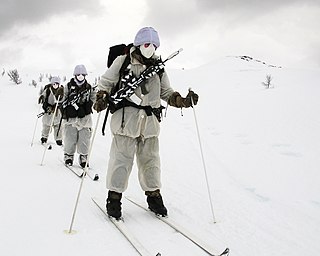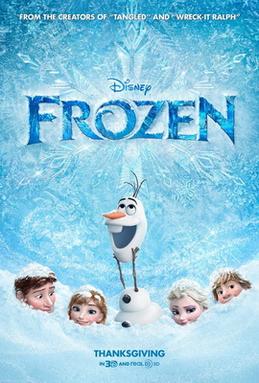Related Research Articles

Snow comprises individual ice crystals that grow while suspended in the atmosphere—usually within clouds—and then fall, accumulating on the ground where they undergo further changes. It consists of frozen crystalline water throughout its life cycle, starting when, under suitable conditions, the ice crystals form in the atmosphere, increase to millimeter size, precipitate and accumulate on surfaces, then metamorphose in place, and ultimately melt, slide or sublimate away.

The cryosphere is an all-encompassing term for those portions of Earth's surface where water is in solid form, including sea ice, lake ice, river ice, snow cover, glaciers, ice caps, ice sheets, and frozen ground. Thus, there is a wide overlap with the hydrosphere. The cryosphere is an integral part of the global climate system with important linkages and feedbacks generated through its influence on surface energy and moisture fluxes, clouds, precipitation, hydrology, atmospheric and oceanic circulation. Through these feedback processes, the cryosphere plays a significant role in the global climate and in climate model response to global changes. Approximately 10% of the Earth's surface is covered by ice, but this is rapidly decreasing. The term deglaciation describes the retreat of cryospheric features. Cryology is the study of cryospheres.
Bryan Campbell Clarke was a British Professor of genetics, latterly emeritus at the University of Nottingham. Clarke is particularly noted for his work on apostatic selection and other forms of frequency-dependent selection, and work on polymorphism in snails, much of it done during the 1960s. Later, he studied molecular evolution. He made the case for natural selection as an important factor in the maintenance of molecular variation, and in driving evolutionary changes in molecules through time. In doing so, he questioned the over-riding importance of random genetic drift advocated by King, Jukes, and Kimura. With Professor James J Murray Jnr, he carried out an extensive series of studies on speciation in land snails of the genus Partula inhabiting the volcanic islands of the Eastern Pacific. These studies helped illuminate the genetic changes that take place during the origin of species.

Cold-weather warfare, also known as arctic warfare or winter warfare, encompasses military operations affected by snow, ice, thawing conditions or cold, both on land and at sea. Cold-weather conditions occur year-round at high elevation or at high latitudes, and elsewhere materialise seasonally during the winter period. Mountain warfare often takes place in cold weather or on terrain that is affected by ice and snow, such as the Alps and the Himalayas. Historically, most such operations have been during winter in the Northern Hemisphere. Some have occurred above the Arctic Circle where snow, ice and cold may occur throughout the year. At times, cold or its aftermath—thaw—has been a decisive factor in the failure of a campaign, as with the French invasion of Russia in 1812, the Soviet invasion of Finland in 1939, and the German invasion of the Soviet Union during World War II.

The Scott Polar Research Institute (SPRI) is a centre for research into the polar regions and glaciology worldwide. It is a sub-department of the Department of Geography in the University of Cambridge, located on Lensfield Road in the south of Cambridge.

The Cold Regions Research and Engineering Laboratory (CRREL) is a United States Army Corps of Engineers, Engineer Research and Development Center research facility headquartered in Hanover, New Hampshire, that provides scientific and engineering support to the U.S. government and its military with a core emphasis on cold environments. CRREL also provides technical support to non-government customers.

Glacier ice accumulation occurs through accumulation of snow and other frozen precipitation, as well as through other means including rime ice, avalanching from hanging glaciers on cliffs and mountainsides above, and re-freezing of glacier meltwater as superimposed ice. Accumulation is one element in the glacier mass balance formula, with ablation counteracting. With successive years in which accumulation exceeds ablation, then a glacier will experience positive mass balance, and its terminus will advance.

Alexander Berzin is a scholar, translator, and teacher of Tibetan Buddhism.

Donald's Snow Fight is an animated short film featuring classic cartoon character Donald Duck in a snowball fight with his nephews Huey, Dewey and Louie. It was released in 1942 by Walt Disney Productions.

The Advocate is the second most dominant daily newspaper in the country of Barbados. First established in 1895, the Advocate is the longest continually published newspaper in the country. Printed in colour, the Advocate covers a wide array of topics including: business, sports, entertainment news, politics, editorials, and special features. In addition the Barbados Advocate also covers investigative journalism, plus local, regional and international news daily.
John Ross Mackay, was a Canadian geographer. He is most noted for his explorations of permafrost phenomena in the western Canadian Arctic. His 40 plus years of study has enabled the building of pipeline operations and petroleum explorations in areas of frozen ground. The Royal Society of Canada stated the following when Mackay was awarded the Willet G. Miller Medal in 1975:

The winter of 1946–1947 was a harsh European winter noted for its adverse effects in the United Kingdom. It caused severe hardships in economic terms and living conditions in a country still recovering from the Second World War. There were massive disruptions of energy supply for homes, offices and factories. Animal herds froze or starved to death. People suffered from the persistent cold, and many businesses shut down temporarily. When warm weather returned, the ice thawed and flooding was severe in most low-lying areas.

Frozen dessert is a dessert made by freezing liquids, semi-solids, and sometimes even solids. They may be based on flavored water, on fruit purées, on milk and cream, on custard, on mousse (semifreddo), and others. It is sometimes sold as ice-cream in South Asia and other countries.

Classifications of snow describe and categorize the attributes of snow-generating weather events, including the individual crystals both in the air and on the ground, and the deposited snow pack as it changes over time. Snow can be classified by describing the weather event that is producing it, the shape of its ice crystals or flakes, how it collects on the ground, and thereafter how it changes form and composition. Depending on the status of the snow in the air or on the ground, a different classification applies.
Dikwa is a town located in Borno State, Nigeria.

Frozen is a 2013 American computer-animated musical fantasy film produced by Walt Disney Animation Studios and released by Walt Disney Pictures. The 53rd Disney animated feature film, it is inspired by Hans Christian Andersen's 1844 fairy tale The Snow Queen. The film was directed by Chris Buck and Jennifer Lee and produced by Peter Del Vecho, from a screenplay written by Lee, and a story by Buck, Lee, and Shane Morris. It stars the voices of Kristen Bell, Idina Menzel, Josh Gad, Jonathan Groff and Santino Fontana. Frozen tells the story of Princess Anna as she teams up with an iceman, his reindeer, and a snowman to find her estranged sister Elsa, whose icy powers have inadvertently trapped their kingdom in eternal winter.
Anna of Arendelle is a fictional character who appears in Walt Disney Animation Studios' 53rd animated film Frozen (2013) and its sequel and 58th animated film Frozen II (2019). She is voiced by Kristen Bell as an adult. At the beginning of the film, Livvy Stubenrauch and Katie Lopez provide her speaking and singing voice as a young child, respectively. Agatha Lee Monn portrayed her as a nine-year-old (singing). In Frozen II, Hadley Gannaway provided her voice as a young child while Stubenrauch is the archive audio.

John Lamplugh Kirk M.R.C.S was a British medical doctor, amateur archaeologist and founder of York Castle Museum in York, North Yorkshire.

Elsa of Arendelle is a fictional character who appears in Walt Disney Animation Studios' 53rd animated film Frozen (2013) and its sequel and 58th animated film Frozen II (2019). She is voiced mainly by Broadway actress and singer Idina Menzel, with Eva Bella as a young child and by Spencer Ganus as a teenager in Frozen. In Frozen II, young Elsa is voiced by Mattea Conforti and Eva Bella.

Jennifer Michelle Lee is an American screenwriter, film director, and chief creative officer of Walt Disney Animation Studios. She is best known as the writer and director of Frozen and its sequel Frozen II, the former of which earned her an Academy Award for Best Animated Feature. Lee is the first female director of a Walt Disney Animation Studios feature film and the first female director of a feature film that earned more than $1 billion in gross box office revenue. She has won an Academy Award, a BAFTA Award and an Annie Award, and has been nominated for one more BAFTA Award and two more Annie Awards.
References
- ↑ Ward, W. H. (1947). "Cryopedology: The study of Frozen Ground and Intensive Frost Action with Suggestions on Nomenclature. By Kirk Bryan American Journal of Science, Vol. 244, 1946, pp. 622–92". Journal of Glaciology. 1 (2): 86–87. doi:10.3189/S0022143000007735. ISSN 0022-1430.